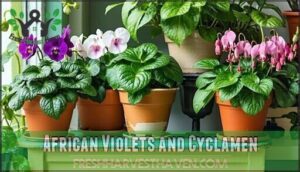This site is supported by our readers. We may earn a commission, at no cost to you, if you purchase through links.
 Winter flowering plants indoors turn your home into a blooming sanctuary when outside gardens sleep under snow. Christmas cacti, amaryllis, and African violets don’t just survive the cold months—they thrive, delivering vibrant petals and sweet fragrances that chase away winter blues.
Winter flowering plants indoors turn your home into a blooming sanctuary when outside gardens sleep under snow. Christmas cacti, amaryllis, and African violets don’t just survive the cold months—they thrive, delivering vibrant petals and sweet fragrances that chase away winter blues.
Give them bright indirect light and steady humidity, and you’ll get months of nonstop blooms that make winter feel less dreary.
From beginner-friendly kalanchoe to dramatic poinsettias, you’ve got options that fit every skill level and living space.
Table Of Contents
- Key Takeaways
- Best Winter Flowering Plants for Indoors
- Essential Care Tips for Winter Bloomers
- Low Maintenance Indoor Flowers for Winter
- Health and Wellness Benefits of Winter Houseplants
- Decorating and Styling With Winter Blooms
- Frequently Asked Questions (FAQs)
- Is there an indoor plant that flowers all year round?
- What indoor plants are good for winter?
- What flowers can still bloom in the winter?
- Can I grow flowers indoors in the winter?
- What potted plants bloom in winter?
- Why do my indoor plants stop blooming suddenly?
- Can I propagate flowering houseplants during winter months?
- What causes leaf yellowing on winter blooming plants?
- How do I transition outdoor plants indoors?
- How can I propagate winter-blooming indoor plants?
- Conclusion
Key Takeaways
- You can grow vibrant flowering plants like Christmas cacti, amaryllis, and African violets indoors during winter when outdoor gardens go dormant. Most winter bloomers need bright indirect light for 12-16 hours daily, proper humidity levels of 50-80%, and nighttime cooling between 55-65°F to trigger blooms. These plants offer health benefits, including air purification, increased humidity for respiratory relief, and mood enhancement during dark winter months. * Low-maintenance options like kalanchoe, snake plants, and rosemary provide continuous blooms with minimal care while staying safe around pets and children.
Best Winter Flowering Plants for Indoors
Winter doesn’t mean your home has to look lifeless and gray.
These carefully selected flowering houseplants will transform your home into a vibrant oasis, bringing bold colors and fresh blooms right when you need them most.
Christmas Cactus and Holiday Cacti Varieties
Imagine this: while your outdoor garden sleeps under a blanket of snow, your Christmas cactus is gearing up to put on the most impressive indoor light show of the year.
These winter-blooming houseplants come in stunning hybrid varieties with bloom colors ranging from deep red to soft pink, white, and even orange.
Holiday cactus varieties like Thanksgiving and Easter cacti offer different blooming schedules, giving you months of vibrant flowers when you need them most.
Poinsettias and Festive Blooms
You can’t walk through a store in December without seeing their bright red bracts calling out like festive beacons, but poinsettias are far more than just holiday decorations. These winter blooms come in stunning poinsettia varieties beyond classic red—cream, pink, and speckled options create beautiful festive arrangements.
Their holiday symbolism runs deep, but remember poinsettia toxicity affects pets and children.
With proper post-holiday care, your holiday plant varieties can thrive year-round.
Amaryllis and Paperwhite Narcissus
Nothing quite captures winter drama like amaryllis bulbs that shoot up towering stems crowned with trumpet-shaped blooms the size of your palm, while their delicate cousins, paperwhite narcissus, fill entire rooms with their intoxicating fragrance.
Both flowering houseplants excel at bulb forcing, requiring just water and patience. Amaryllis delivers striking winter blooms in six weeks, while paperwhites burst forth in three. Note their toxicity levels around pets and children.
African Violets and Cyclamen
While amaryllis dominates with its towering trumpet blooms, African violets and cyclamen prove that sometimes the most enchanting winter flowers come in smaller, more delicate packages. These winter-blooming houseplants offer continuous color when outdoor gardens sleep.
African violets thrive with proper humidity needs and light spectrum conditions:
- Bright, indirect light for 12-14 hours daily
- 50-60% humidity using pebble trays
- Violet propagation through leaf cuttings works year-round
- No dormancy period required for flowering houseplants
Cyclamen provides heart-shaped foliage with delicate blooms, though cyclamen toxicity requires caution around pets and children.
Anthuriums, Bromeliads, and Oxalis
Think of these three as the party guests who never need an invitation – anthuriums, bromeliads, and oxalis bring bold colors and exotic flair to your winter windowsill without asking for much in return.
Anthurium varieties showcase glossy heart-shaped blooms in pink, red, or white that last for months. Bromeliads offer tropical aesthetics with their colorful flower clusters, while oxalis propagation is simple – just divide the bulbs for endless shamrock-shaped leaves and delicate winter-blooming houseplants that’ll brighten any room.
Essential Care Tips for Winter Bloomers
Winter bloomers need the right setup to actually flower, but once you nail down their preferences, they’ll reward you with blooms when everything else looks dead.
These plants are basically picky about their growing conditions, but get it right and they’ll bloom beautifully while everything else looks dormant.
Bright Indirect Light Requirements
Most flowering houseplants are like solar panels in disguise—they need that sweet spot of bright light without the harsh burn of direct sun to keep those blooms coming all winter long. Place your winter-blooming houseplants near east or south-facing windows where they’ll get 12-16 hours of bright, indirect sunlight daily. Watch for leaf burn if light intensity gets too strong.
- Plant placement: Position flowering plants 3-6 feet from windows to avoid direct rays
- Light duration: Make certain of 12-16 hours of bright light daily for consistent blooming
- Spectral quality: Winter sun provides less red light, so supplement with grow lights if needed
- Light intensity: Monitor for yellowing leaves (too little) or brown spots (too much)
- Indoor plants rotation: Turn pots weekly so all sides receive equal light exposure
Maintaining Proper Humidity and Moisture
Did you know that keeping your winter houseplants happy often comes down to balancing moisture in the air, almost like tuning an instrument to get the perfect note? Your watering frequency should drop to every 7-14 days since indoor plant care changes dramatically in winter.
Humidity levels between 50-80% prevent root rot while guaranteeing proper soil drainage. Misting benefits most flowering plants, creating ideal growing conditions despite reduced plant light requirements during shorter days.
Soil and Fertilizer Needs in Winter
Winter bloomers are less demanding than summer plants when it comes to feeding, but soil quality can still make the difference between thriving blooms and disappointment.
Choose potting mixes that drain well and let roots breathe—soggy soil kills more houseplants than neglect ever will.
During dormancy, fertilizing should be minimal—think quarter-strength liquid fertilizer monthly. Watch for nutrient deficiency signs like pale leaves, which often signal your soil conditions need attention.
Temperature and Bloom Triggers
Unlike many plants that coast through winter, your winterblooming houseplants need specific temperature conditions to trigger bud formation. Most require nighttime cooling between 55°F-65°F with at least a 10°F drop from daytime temps.
Holiday cacti won’t bloom without this temperature stress combined with proper photoperiod impact—12-14 hours of darkness nightly. To encourage blooming, consider providing uninterrupted darkness for prime bud development.
Temperature consistency matters more than you might think for prime growing conditions during bloom time.
Pruning, Repotting, and Dormancy Management
Winter doesn’t mean your plants have to suffer. Keep your green friends thriving with these three smart pruning moves:
- Deadheading spent blooms – Remove faded flowers to encourage new buds and extend the flowering period
- Light root pruning – Trim circling roots during repotting frequency checks every 2-3 years for best growing conditions
- Dormancy period respect – Let plants like oxalis rest naturally, supporting their propagation methods and soil and fertilizer needs for spring renewal
Low Maintenance Indoor Flowers for Winter
Not all winter bloomers require constant attention to keep their flowers coming. Some plants practically take care of themselves while still delivering gorgeous blooms that’ll brighten your home during the darkest months.
Snake Plant and Peace Lily Resilience
Sometimes the toughest plants surprise you with their gentle side, and snake plants along with peace lilies prove that resilience doesn’t mean sacrificing beauty.
These champions of drought tolerance and air purification thrive in low light conditions with minimal care requirements. Their light adaptability makes them perfect for darker winter corners, while their pest resistance means you won’t battle bugs when heating systems create stress.
Both flowering plants reward your indoor gardening efforts without demanding constant attention.
Kalanchoe and Easy-Blooming Options
Imagine this: you’re browsing the houseplant aisle in February, and there’s kalanchoe sitting pretty with clusters of tiny flowers in every color from soft pink to vibrant orange. These Kalanchoe varieties are practically foolproof for winter gardening beginners, blooming for months with minimal care.
- Long blooming periods – Flowers last 6-8 weeks with proper light
- Easy propagation from leaf cuttings for endless plants
- Beginner blooms that forgive occasional watering mistakes
Rosemary and Non-Toxic Choices
When you want stunning blooms without worrying about Fluffy or little hands getting into trouble, rosemary becomes your fragrant hero in the winter plant world.
This aromatic herb produces delicate blue, purple, or white flowers while staying completely safe for pets and children. Unlike toxic plants that require constant vigilance, rosemary offers peace of mind alongside its pine-like scent and culinary benefits, making houseplant selection simple for families.
Best Flowering Bulbs for Beginners
Nothing beats the thrill of watching a bulb you planted transform into a striking winter bloom right on your windowsill. These Easy Bulb Choices deliver stunning flowering houseplants with minimal fuss during the winter months:
- Amaryllis – dramatic trumpet blooms in 6-8 weeks
- Paperwhite – fragrant clusters, no chilling required
- Hyacinth – intense fragrance, pre-chilled bulbs work best
- Crocus – delicate cups in purple, white, yellow
- Tulips – compact varieties thrive in cool spots
Focus on proper potting mix selection with good drainage. Watering best practices mean keeping soil moist but never soggy. Most need bright, indirect light requirements. Common beginner mistakes include overwatering and insufficient light.
Health and Wellness Benefits of Winter Houseplants
Your winter houseplants do way more than add pretty blooms to dreary rooms.
These green companions actually work overtime to clean your air, bump up humidity, and give your mood the boost it needs when the days get short and cold.
These flowering companions purify your air, increase humidity levels, and provide therapeutic benefits that help combat winter blues while supporting your respiratory wellness.
Stress Reduction and Mood Enhancement
There’s something almost magical about how a splash of color from blooming houseplants can lift your spirits when the world outside looks gray and lifeless. Research shows that plant therapy delivers real mood-boosting benefits, especially during winter’s darker months. Your brain reacts to flowering plants by releasing feel-good chemicals that combat seasonal blues.
Research shows that blooming houseplants actually trigger your brain to release mood-boosting chemicals that combat winter’s gray days and seasonal blues
Growing plants indoors creates a nurturing routine that grounds you. The simple act of houseplant care—watering, pruning, checking for new buds—gives your mind something positive to focus on. These flowering beauties transform your home decor while working overtime as natural antidepressants.
| Stress Relief Benefits | Cognitive Benefits | Emotional Wellbeing |
|---|---|---|
| Lowers cortisol levels | Improves focus | Reduces anxiety symptoms |
| Decreases blood pressure | Enhances memory | Boosts self-esteem |
| Relaxes muscle tension | Increases creativity | Promotes calm feelings |
| Improves sleep quality | Sharpens attention | Encourages mindfulness |
Air Purification and VOC Removal
Your flowering houseplants don’t just brighten winter days—they’re working overtime to clean your air. These botanical powerhouses tackle harmful chemicals through elaborate VOC absorption mechanisms, with peace lilies and spider plants achieving formaldehyde removal rates up to 75-95%. Here’s what makes them effective air purifiers:
- Benzene elimination reaches 79% with English ivy and bamboo palm
- Species effectiveness varies, with snake plants consistently outperforming others
- Air quality outcomes show 40-65% VOC reduction in multi-plant setups
Growing houseplants indoors under ideal growing conditions maximizes their purification potential, making plant care both rewarding and health-conscious. A study by NASA in 1989 explored houseplants’ air-purifying capabilities.
Humidity Boost and Respiratory Relief
Breathing easier starts with your indoor winter plants. Plant transpiration naturally raises humidity levels from a harsh 20% to a comfortable 40-50%, relieving dry throats and irritated sinuses that plague winter months.
Growing houseplants indoors creates an environment where viral transmission drops noticeably—viruses thrive in dry air but struggle when humidity climbs above 30%. Your respiratory comfort improves as indoor plants trap airborne allergens and reduce dust suspension.
Houseplant care becomes especially valuable for asthma sufferers, since proper humidity and air quality from indoor winter plants help prevent respiratory flare-ups during cold seasons.
Therapeutic Effects of Plant Care
Tending to your winter blooms isn’t just about watering and light—it’s like having a gentle therapist right in your living room. The simple act of houseplant care triggers measurable stress reduction while boosting mental wellbeing through sensory stimulation and cognitive benefits that horticultural therapy practitioners have documented for decades.
- Daily routines create structure and purpose during winter months
- Tactile engagement with soil and leaves provides grounding sensory experiences
- Problem-solving skills develop through observing plant needs and responses
- Mindfulness practice emerges naturally during indoor gardening sessions
- Achievement satisfaction grows with each new bloom or healthy leaf
Decorating and Styling With Winter Blooms
Think of winter blooms as your indoor design ace—they let you create gorgeous displays that put expensive flower shops to shame.
You can transform your living space into a vibrant sanctuary by strategically combining colorful houseplants with your existing décor, all while keeping your family and pets safe.
Creating Festive Centerpieces
Transform your winter blooms into show-stopping centerpieces that’ll make your dining table the star of every gathering.
Group flowering houseplants in coordinating containers at varying heights for visual interest. Choose fragrant varieties like paperwhites or rosemary for fragrance pairing that enhances your holiday season atmosphere.
Select containers that complement your home decor with plants, making sure proper table placement doesn’t overwhelm your space.
Mixing Flowering Plants for Vibrant Displays
Your living space becomes more vibrant when you mix different flowering plants together—the contrast creates depth and visual interest that single varieties can’t match.
Start with height variation by pairing tall amaryllis with compact African violets, then add texture combinations through smooth anthurium leaves against fuzzy cyclamen foliage.
Plan bloom succession so different flowering houseplants take turns creating color harmony throughout winter months.
Pairing Plants With Home Décor
Your winter blooms don’t just brighten rooms—they can actually complement and elevate your existing home décor when you choose the right pots, placement, and plant combinations. Plant color schemes work best when they echo your room’s palette, while container material choices can bridge modern and traditional styles.
- Match flowering houseplants to your room style – sleek ceramic pots for contemporary spaces, woven baskets for farmhouse aesthetics
- Create foliage texture contrast by pairing smooth cyclamen leaves with spiky rosemary or soft African violet foliage
- Choose container material choices that indoor aesthetics – copper for warm tones, white ceramics for minimalist décor
- Plan seasonal décor integration where winter houseplants complement existing holiday elements without overwhelming the space
Safety Tips for Pets and Children
Beautiful blooms can quickly turn dangerous when curious pets and little hands get involved—some of winter’s most popular flowering houseplants pack a toxic punch that requires your attention.
Keep poinsettia and cyclamen out of reach using high shelves or childproof containers. Choose pet-safe alternatives like African violets when toxicity concerns arise.
If ingestion occurs, contact poison control immediately.
Frequently Asked Questions (FAQs)
Is there an indoor plant that flowers all year round?
African violets come pretty close to being the champions of year-round blooming, producing delicate flowers almost continuously when you give them the right care.
These continuous bloomers need consistent lighting and regular fertilization schedules to maintain their flowering cycles throughout all seasons.
What indoor plants are good for winter?
When winter’s chill sets in and your garden goes dormant, a surprising variety of houseplants actually hit their blooming stride indoors. Christmas cacti, cyclamen, and African violets thrive in cooler temperatures while poinsettias and amaryllis create stunning focal points for your home.
What flowers can still bloom in the winter?
While most gardens lie dormant under winter’s icy grip, a surprising number of flowers refuse to surrender to the cold and continue their colorful rebellion right on your windowsill.
Christmas cacti, cyclamen, African violets, and amaryllis create stunning winter displays indoors when outdoor blooms have long disappeared.
Can I grow flowers indoors in the winter?
Forget what you know about houseplants going dormant when the temperature drops—many indoor varieties actually hit their blooming stride during winter’s chill.
You can absolutely grow flowering plants indoors during winter, transforming your home into a vibrant garden sanctuary when outdoor blooms fade away.
What potted plants bloom in winter?
Imagine this: your windowsill becomes a colorful garden party while snow blankets everything outside. Several potted plants bloom beautifully during winter months, bringing vibrant colors when you need them most.
Why do my indoor plants stop blooming suddenly?
It’s heartbreaking when your favorite flowering plant just stops blooming overnight, like someone flipped an off switch.
Your houseplants can suddenly quit flowering due to several common environmental and care problems.
- Light requirements aren’t met – Most flowering plants need 12-16 hours of bright, indirect light daily for consistent bud production
- Nutrient deficiencies develop – Without proper fertilizer during growing seasons, plants lack energy reserves for blooming
- Dormancy periods begin naturally – Many plants enter rest phases where they stop flowering to conserve energy for survival
Can I propagate flowering houseplants during winter months?
Most gardeners don’t realize that winter’s slower growth actually creates the perfect conditions for successful propagation of many flowering houseplants. Lower temperatures and reduced metabolic activity help cuttings focus energy on developing strong root systems rather than supporting rapid leaf growth.
| Plant Type | Best Winter Propagation Method | Success Rate | Timeline |
|---|---|---|---|
| Christmas Cactus | Stem cuttings in water | 85-90% | 3-4 weeks |
| African Violets | Leaf cuttings in soil mix | 70-80% | 6-8 weeks |
| Begonias | Stem or leaf cuttings | 75-85% | 4-6 weeks |
| Pothos | Stem cuttings in water/soil | 95% | 2-3 weeks |
Winter propagation success depends heavily on managing dormancy impact and rooting challenges. The key lies in understanding how humidity and light influence affect your houseplants during their slowest growth period. Most indoor plants experience reduced transpiration rates, which actually helps prevent cutting stress.
Plant propagation techniques work differently in winter because lower light levels slow cellular activity. You’ll need to adjust your expectations—root development takes 30-50% longer than spring propagation. However, this extended timeline often produces stronger, more established root systems.
Winter gardening tips for successful propagation include maintaining consistent soil moisture without overwatering, providing bright indirect light for 12-14 hours daily, and keeping humidity levels between 60-70%. Avoid fertilizing newly propagated plants until active growth resumes in spring, as excess nutrients can actually harm developing roots during dormancy periods.
What causes leaf yellowing on winter blooming plants?
Yellow leaves on your winter bloomers often signal that something’s gone wrong with their care routine, and the culprit is usually lurking in your watering habits or lighting setup. Here are four main causes to check:
- Overwatering effects – Soggy soil conditions create root rot, blocking nutrient uptake
- Light intensity problems – Insufficient light requirements make houseplants struggle and yellow
- Temperature fluctuations – Cold drafts or heat stress damage leaf cells
- Nutrient deficiencies – Poor fertilizer schedules leave indoor plants starving for nitrogen
How do I transition outdoor plants indoors?
Moving plants from your garden to cozy indoor spots doesn’t have to feel like you’re uprooting your entire world. The acclimation process requires gradual light adjustment over two weeks to prevent temperature shock.
| Week 1 | Week 2 |
|---|---|
| Inspect for pests thoroughly | Check soil conditions daily |
| Reduce watering frequency | Adjust humidity needs gradually |
| Move to shaded outdoor area | Begin indoor flower gardening setup |
| Monitor for stress signs | Select final winter plant locations |
| Quarantine from other houseplants | Establish light requirements routine |
Start pest prevention early and adjust gradually for successful indoor transitions.
How can I propagate winter-blooming indoor plants?
Multiplying your favorite winter bloomers is like discovering a secret vault of future flowers just waiting to unfold. Most houseplants respond well to simple plant propagation techniques during their active growing periods.
- Leaf cuttings work perfectly for African violets and begonias
- Stem propagation suits Christmas cactus and anthurium varieties
- Division methods multiply cyclamen and oxalis effectively
Conclusion
Your home doesn’t have to hibernate during the dreary months ahead. Winter flowering plants indoors transform cold spaces into vibrant sanctuaries when outdoor gardens rest beneath frost’s blanket.
These resilient bloomers offer continuous color through proper care—bright indirect light, balanced humidity, and seasonal adjustments.
From beginner-friendly kalanchoe to dramatic amaryllis, you’ll discover reliable companions that brighten the shortest days and longest nights ahead.
- https://www.marthastewart.com/houseplants-that-bloom-during-winter-8768414
- https://ngb.org/9-winter-blooming-houseplants/
- https://www.1800flowers.com/articles/flower-facts/best-winter-indoor-plants-and-flowers
- https://fieldreport.caes.uga.edu/publications/B1318/growing-indoor-plants-with-success/
- https://www.provenwinners.com/learn/houseplants/winter-care















